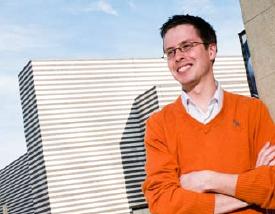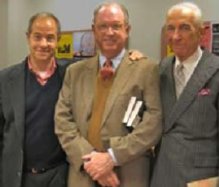On a spring morning in 2004, as members of the Cleveland Orchestra gathered in Severance Hall for a rehearsal, a visitor took a seat at the back of the stage. Charles Michener, a writer and editor on assignment from The New Yorker, had arrived early enough to watch the musicians file in and unpack their instruments. He looked on as they started "tooting, blaring, bowing, and pounding, warming up fingers, arms, and lungs." And in his story, published several months later, he seemed to remember every detail: the preliminaries ending in silence, the conductor arriving and glancing at the concertmaster, the concertmaster nodding in return.
The description was calm and detached, right up to the moment when the conductor raised his arms towards the players. But then, Michener wrote, "they were off"— and so was he:
"To be inside an orchestra like the Cleveland is to feel your nerve endings exposed. You acquire a new set of ears. You're sitting perfectly still, yet your heart is racing. You feel a hundred pairs of ears, eyes, arms, and hands working as one to give shape, direction, pulse, color, and meaning to the insubstantiality of sound. You feel the intensity of a hundred people listening to one another."
Amidst all that frenetic movement, the most intense activity turned out to be "listening," not performing. This is what Michener noticed once he got inside the orchestra. It's what readers learned, to their slight surprise, as they came to the end of a paragraph with its own shape, direction, pulse, and color.
For an apprentice writer, a careful look at such a passage would be an education in itself. But this semester, the English department has offered students in the College a further opportunity: the chance to write directly under Charles Michener's guidance, as members of the Norman Wain Journalism Seminar. By the end of the term, each of his students will have completed a New Yorker-style narrative about a University Circle institution or a local site (Little Italy, Lake View Cemetery) of cultural and historical significance. In addition, they will have met several of the nation's most distinguished nonfiction writers, who will take part in the seminar and deliver four public lectures (see sidebar).
"I am trying to get the students to write rich, compelling stories—not articles, not pieces, not papers, but stories that take the reader through a subject," Michener says. "I'm helping guide them through the research—the questions that have to be asked, the kind of access you need to get. And then, having been a senior editor for many years, I will work with them as though I'm their New Yorker editor." It's as if students in a conservatory were suddenly being invited to play for the conductor of the Cleveland Orchestra.
A Cleveland Explorer
The idea for the seminar first came to Michener during his reporting trip to Cleveland in 2004; he looked at University Circle and saw a perfect training ground for cultural journalists. At the same time, he sensed that his story about the orchestra and the city might be the starting point for a book. Not content to commute between New York and Cleveland as he worked on the project, in 2007 Michener bought an apartment in Cleveland Heights, situated "where the city changes dramatically into one of its old, lofty suburbs." And that was when Ted Gup, the Shirley Wormser Professor of Journalism, gave him a call.
Gup had been conferring with Norman Wain, a longtime benefactor of the College, about bringing a distinguished writer or editor to campus to organize a lecture series and possibly teach a course. Wain has spent his entire career in the broadcast industry—as a radio personality, an owner of WDOK in Cleveland, and a founder of Metroplex Communications. For 10 years, he taught a course on mass media for the College's department of communication sciences. Once Wain gave his support to the project, Gup started recruiting.
"One of the first people I had my eye on was Charles Michener," he says. "He was at Newsweek for years, writing about cultural affairs. He's written well-received books, and during his time at The New Yorker, he worked with some of the greatest writers in this country. When I called Charles to see if he was interested, it turned out that he was doing a book on northeast Ohio. He was enthusiastic from the get-go, so we jumped at it."
For Michener, writing and teaching in Cleveland has meant returning to scenes of his youth. He grew up in Pepper Pike, then a rural neighborhood, distant from the city, but he acquired an early fascination with urban life and culture. "I really had my nose pressed to the glass of Cleveland," he says. "I loved being in Cleveland— exploring the downtown, going to all of the sports games. I was a jazz fanatic; I was a regular at the Modern Jazz Room at Fourth and Prospect, where I sat two feet from Art Tatum, Ella Fitzgerald, and Dizzy Gillespie. I got myself backstage during the Metropolitan Opera's annual visit to the Public Auditorium. I was a Cleveland explorer." Still, when he left at age 17 to attend Yale, he didn't think he would ever live here again.
In the 1970s and early 1980s, Michener made his reputation as chief cultural writer for Newsweek, profiling leading figures in theater and film, music, literature, and the visual arts. This was a time, he says, when the national news magazines did "a tremendous amount of cultural coverage"—when no one was surprised to see a cover story on V. S. Naipaul, Richard Avedon, or Liv Ullmann, or to learn that Michener had written it. Later, as a senior editor at The New Yorker, he would pursue an even wider range of interests, venturing well beyond cultural journalism. Many important books, from John Bayley's Elegy for Iris to Lawrence Wright's The Looming Tower: Al Qaeda and the Road to 9/11, originated as New Yorker articles that he saw into print.
In recent years, Michener has written extensively about classical music (his profile of the late mezzo-soprano Lorraine Hunt Lieberson is available on The New Yorker's website), and he has long been a concert reviewer for the New York Observer. When he planned his visit to Cleveland in 2004, all he had in mind was a piece about the orchestra and its new music director, Franz Welser-Möst. But once he got here, he realized that "the larger story, the more profound story," was contained in a question that would eventually become the subtitle of his article: "Can an orchestra survive its city?" And soon, in a spirit quite different from the one that had moved him when he was a restless teenager from Pepper Pike, he was exploring Cleveland again.
"If you approach Severance Hall from downtown, you drive through several miles of urban dilapidation and patchy renewal: shut-down factories that once manufactured machine tools; faded frame houses with sagging front porches; an occasional car wash or soul-food restaurant; a cluster of new town houses that might have been dropped from the sky."
His book-in-progress is, on one level, a memoir about his return to Cleveland. On another, it is "a portrait of a once wealthy city trying to find a new identity, having fallen on hard times and now struggling for a new economy in the 21st century." Finally, it is a study of urban areas across the Midwest that "have gone through the same downturn and have tried to reinvent themselves, with varying degrees of success."
The book's working title is The Hidden City. "I believe," says Michener, "that Cleveland is hidden to itself "—its virtues concealed by a "negative vibe that has been propagated to a large extent by Clevelanders themselves," its renewal efforts hampered by a failure to recognize the sources of its past glory. "What Cleveland needs to do is rediscover what made it great in the first place—innovation, immigration, the dedication to weaving a social fabric."
Like all of Michener's work, the book relies on narrative rather than argument. It tells its story "through a variety of characters, each one a kind of gatekeeper to a different aspect of the city's tapestry."
Opening Doors

Photo by Daniel Milner
Adam Rupe, a senior in the Norman Wain seminar, has spent the term pursuing his own "multifaceted" project. In part, his story will be a profile of Timothy Rub, the new director of The Cleveland Museum of Art. But it will also examine the museum's current renovation and expansion, its relationship with the relationship with the Cleveland community and the rest of University Circle, and the "changing world of art museums" in the 21st century.
In true New Yorker style, Rupe has been industrious in gathering details. He observed the installation of the museum's latest exhibition, "Arms and Armor," as the staff were "adjusting light bulbs and screwing on placards." He learned that when the museum closed for construction, the number of memberships actually went up, "because people wanted to help the project go forward."
Rupe has worked with one of the museum's media relations officers, interviewed the registrar who oversees the storage of the permanent collection, spoken with Steven Litt, art and architecture critic for The Plain Dealer, and interviewed Timothy Rub himself. In some cases, Rupe says, Michener helped him gain access to sources: "Charles is so well connected; he's opened doors. He seems to know everybody here in University Circle."
Each week in the seminar, the students report on their progress, explaining how their story ideas are developing and mentioning obstacles they have encountered in their research. "Charles grills us, sort of," Rupe says. "But now we're becoming more expert, so we also grill each other. We'll ask: 'Did you think to look at it from this angle?'"
The students also join in discussions of published work that Michener has chosen for their consideration. "In this class, you're looking at a piece sentence by sentence, word by word, syllable by syllable," Rupe says. "You see how the beat of the words comes together to form a cadence."
For his part, Michener notes that this kind of scrutiny can provoke criticism as well as admiration. "We analyzed an award-winning piece of journalism where we found something wrong with nearly every other sentence," he says. "By 'wrong,' I mean superfluousness, clichés, tendentiousness."
The day that visiting journalist Gay Talese joined the seminar, the students presented drafts of their lead paragraphs. Talese was hard on them, Rupe admits— "very intimidating," in fact. On the other hand, he spent several minutes helping one student come up with a new story idea. Then, after Talese gave a well-attended public talk in Clark Hall, they all went to Primo Vino for dinner.
Michener tells his students that every story involves a three-way interaction among writer, subject, and reader. "You can't ever lose sight of the reader—just as, if you're telling a story around a campfire, you can't lose sight of the children," he says. "It's a matter of choosing the correct detail, the right tone, how to structure the different episodes, how to weave background information with foreground reporting." Meanwhile, the seminar maintains its own alternating balance between teaching by example and learning by doing.
"We put this together very quickly, and I would hope that it could be an ongoing course," Michener says. "I also hope that the students' finished stories will be published in a journal entitled The Circle, to be distributed on campus and in the surrounding institutions and shops. The biggest obstacle to change in northeastern Ohio is fragmentation. I see The Circle as a vehicle for connecting the dots."

